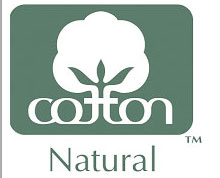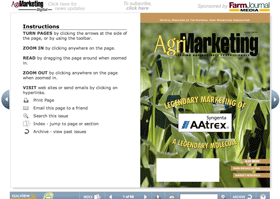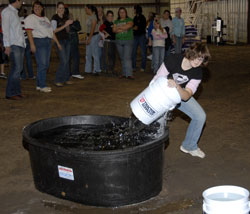 John Deere says that their new 7760 Cotton Picker will revolutionize harvesting the crop.
John Deere says that their new 7760 Cotton Picker will revolutionize harvesting the crop.
This machine was on display in action at last week’s Sunbelt Ag Expo. Southeast AgNet’s Randall Weiseman was on hand to obtain interviews for me. He spoke with Jamie Flood, Deere’s Cotton Marketing Manager, who worked with the 7760 development in Iowa. You can listen to Randall’s interview here: 10-17-07%20John%20Deere-Jamie%20Flood.mp3
 Here’s what makes the machine special:
Here’s what makes the machine special:
The 7760 Picker will build a round module on the machine while harvesting cotton. Then it will wrap the cotton module in a protective film to preserve fiber and seed quality, and minimize any crop loss during handling and transport. Without ever stopping the machine during picking, the operator can then carry the module to the end of the field to be transported later to the gin. This efficient, non-stop harvesting system eliminates unloading into a boll buggy and processing in a module builder. Ultimately, the producer saves time, fuel and manpower when harvesting and processing the cotton.
Besides Jamie, Randall also spoke with Barry Nelson, Deere’s Manager of Public Relations.
You can listen to Randall’s interview with Barry here: 10-17-07%20John%20Deere-Barry%20Nelson.mp3

 At the Country Living Outlook Conference one of the speakers on our program was country lifestyler, Kelly Loganbill. Kelly works in town and makes an 80 plus mile round trip each day from her home.
At the Country Living Outlook Conference one of the speakers on our program was country lifestyler, Kelly Loganbill. Kelly works in town and makes an 80 plus mile round trip each day from her home. Beef isn’t just what’s for dinner anymore. It’s what’s for your ipod… or itunes, or any mp3 compatible gadget for that matter.
Beef isn’t just what’s for dinner anymore. It’s what’s for your ipod… or itunes, or any mp3 compatible gadget for that matter.  The “green” trend that’s picking up steam in the U.S. is giving the cotton industry an incentive to promote its “natural” quality.
The “green” trend that’s picking up steam in the U.S. is giving the cotton industry an incentive to promote its “natural” quality.  I’ll add a picture to this post later. Right now I’m at one of my favorite coffee shops using
I’ll add a picture to this post later. Right now I’m at one of my favorite coffee shops using  Reaching people who live the country life has been the subject of several articles in
Reaching people who live the country life has been the subject of several articles in  Besides talking about country living we also talked about Agrimarketing Magazine going digital. I read my
Besides talking about country living we also talked about Agrimarketing Magazine going digital. I read my 
 Caitlin Williams, Tucson, Ariz. (pictured right), won the title of 2008 National Beef Ambassador at the annual competition, held Oct. 18-20 in New Orleans, La. The competition was established on behalf of cattle producers in 1988 and is funded by the
Caitlin Williams, Tucson, Ariz. (pictured right), won the title of 2008 National Beef Ambassador at the annual competition, held Oct. 18-20 in New Orleans, La. The competition was established on behalf of cattle producers in 1988 and is funded by the  Water Bucket Filling would not be my favorite chore out on the farm but it’s just one of those things you have to do. I prefer taking pictures of other people doing it for competition.
Water Bucket Filling would not be my favorite chore out on the farm but it’s just one of those things you have to do. I prefer taking pictures of other people doing it for competition. If you know Steve Drake then you know he likes to work in the background. In fact, after taking about 500 pictures at the Country Living Association activities last week none of them have Steve in it.
If you know Steve Drake then you know he likes to work in the background. In fact, after taking about 500 pictures at the Country Living Association activities last week none of them have Steve in it.